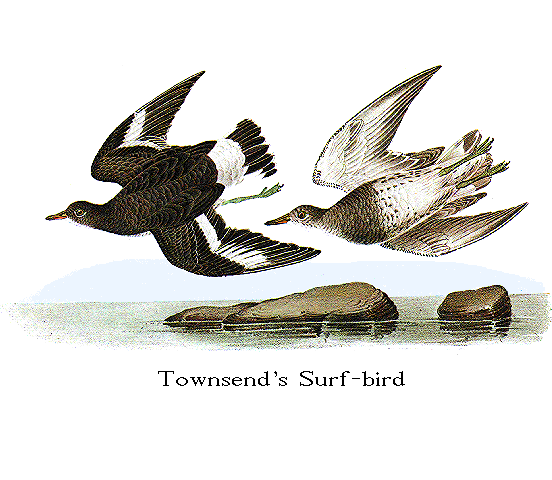Birds of America
By John James Audubon, F. R. SS. L. & E.
VOLUME V.



Family
Genus

TOWNSEND'S SURF-BIRD.
[Surfbird.]
APHRIZA TOWNSENDI, Aud.
[Aphriza virgata.]

PLATE CCCXXII.--FEMALE.
The remarkable bird here represented, which in form and size bears a
considerable resemblance to the Knot, was procured by Mr. TOWNSEND on the shores
of Cape Disappointment, and proved to be a female. Nothing is known as to the
habits or range of the species. In order to exhibit its characters to the best
advantage, I have figured it flying in two different aspects. The following
note accompanied the specimen sent to me by Mr. TOWNSEND:--"I shot this bird,
the only one I have ever seen, on Cape Disappointment, at the entrance of the
Columbia river. It was sitting on the edge of the steep rocks, and the heavy
surf frequently dashed its spray over it as it foraged among the retreating
waves. When it started, it flew with a quick, jerking motion of its wings, and
alighted again at a short distance. It was a female. The stomach was
remarkably strong and muscular, and contained fragments of a small black
shell-fish which adheres to the rocks in this neighbourhood."
TOWNSEND'S SURF-BIRD, Aphriza Townsendi, Aud. Orn. Biog., vol. v. p. 249.
Female, 11; wing, 7 1/2
Cape Disappointment, Columbia river.
Female.
Bill a little shorter than the head, rather stout, compressed, tapering,
straightish, being recurvate in a slight degree. Upper mandible with the dorsal
line straight and a little declinate as far as the middle, then concave, and
towards the end convex, the nasal groove extending to near the end, the ridge
rather broad and flattened, the tip compressed and bluntish. Lower mandible
with the angle rather long and narrow, the dorsal line ascending and slightly
convex, the sides grooved for half their length, convex toward the end, the tip
narrowed but blunt. Nostrils sub-basal, linear near the margin.
Head rather small, ovate, rounded in front. Neck of ordinary length. Body
rather full. Feet of moderate length, rather stout; tibia bare at the lower
part, and reticulated; tarsus roundish, with small angular scales all round,
those on the fore part larger; toes four, with numerous scutella, the first very
small and placed higher than the rest; the anterior toes free to the base,
distinctly margined on both edges, flat beneath, the inner considerably shorter
than the outer, the third a quarter of an inch longer than the latter; claws
rather small, curved, compressed, blunted.
Plumage full, soft, rather dense, on the neck and lower parts blended.
Wings very long, narrow and pointed; primaries with strong shafts, narrowed
towards the end, the first longest, the rest rapidly decreasing; outer
secondaries incurved, obliquely rounded, inner elongated, one of them reaching
to an inch and two-thirds of the tip of the longest primary when the wing is
closed. Tail rather short, even, of twelve moderately broad, rounded feathers.
Bill dusky toward the end, orange at the base. Feet bluish-green, claws
black. The general colour of the upper parts is a very dark or blackish-grey;
the quills greyish-black; a broad band of white crosses the wing, occupying the
tips of the primary coverts, the terminal third of the secondary coverts, the
bases and more or less of the margins and tips of the quills, several of the
inner secondaries having only a streak of dusky on the inner web, but the
innermost or elongated quills are destitute of white. The shafts of the quills
are also white, as are some of the feathers of the rump, the upper tail-coverts,
the basal half of the tail, of which the rest is black, the feathers narrowly
edged with white at the end; the black on the tail is narrower on the lateral
feathers, and on the outer does not occupy much more than half an inch. The
throat is greyish-white; the cheeks, sides, and fore part of the neck, and the
anterior part of the breast dull grey, of a lighter tint than the back; the rest
of the lower parts white, with small longitudinal oblong dark grey streaks; the
axillaries and lower wing-coverts white, those at the edge of the wing dark
grey, with white margins.
Length to end of tail 11 inches; bill from flexure 1 (1 1/4)/12, along the
edge of lower mandible 1 (1 1/2)/12; wing from flexure 7 1/2; tail 3 2/12;
tarsus 1 2/12; hind toe 2/12, its claw 2/12; middle toe (11 1/4)/12, its claw
3/12.
The prominence on the terminal part of the upper mandible gives the bill
somewhat of the appearance of that of a Plover, but in other respects it more
resembles that of the Turnstone, the plumage agrees with that of the latter
bird, and the colouring is very similar to its winter dress. This species in
short seems intermediate between Tringa and Strepsilas, but is much more allied
to the latter, with which it agrees in form and proportions, the principal
differences being in the tail, which is not rounded, but even, in the want of
scutella on the tarsi, and in the form of the bill at its extremity, the upper
mandible in place of being a little recurvate and depressed, having its
extremity arched and the point a little decurved. Were the latter worn off, it
would agree with that of Strepsilas. Conceiving this bird to present characters
sufficient to constitute a sub-genus in immediate connection with Strepsilas, I
propose to give it the name of Aphriza Townsendi, the generic appellation
(derived from [aphroz] and [xao]) being expressive of the habit of the bird, as
indicated in the notice of its discoverer, who appears to me to have the best
claim for the specific name.









